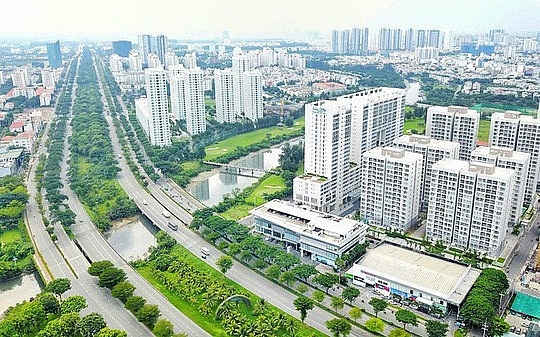US-China trade war heats up real estate market
 |
| Booming demand for industrial property from the US-China trade war is sending impacts across the entire real estate spectrum |
The impacts of the US-China trade war are already felt across the Vietnamese real estate market, benefitting some segments while challenging others.
At present, industrial real estate has numerous advantages attracting overseas investors, with a lot of economic zones, industrial zones, international and regional integration, and rapid growth. Besides, Vietnam has low-cost labour force in abundance.
According to CBRE, industrial real estate in the northern provinces will be affected by the US-China trade war because of its proximity to China, especially in industrial zones in Bac Ninh, Haiphong, Quang Ninh, Hung Yen, Hai Duong, and some other southern industrial zones.
Explaining this case, Nguyen Hoai An, director of CBRE Vietnam’s Hanoi branch, said that corporations usually apply the “China+1” model. “They build a facility in China and then look for a new destination to become an intermediary location or to serve as a target for expansion and relocation in the future,” said An.
During the year-long US-China trade war, more and more corporations have been eyeing Vietnam as a destination. “Therefore, the number of transactions that CBRE did over the past year has increased significantly, by 25-30 per cent compared to previous years, and this could be maintained for the next several years,” An added.
Thanks to this trend, the general northern real estate market has also heated up. The development of industrial zones has sent rpipples through the housing and other markets, especially in the west of Hanoi and areas surrounding West Lake.
Catching up with this trend, the number of newly-launched condominiums is increasing, especially in the west of Hanoi. According to CBRE, 26,800 units were newly launched during the first nine months of 2019, up by 37 per cent on-year. Launched projects in this quarter are also mostly located in the city west, accounting for 77 per cent of the total newly launched units.
In the last quarter of 2019, approximately 7,000 units are expected to be launched, bringing the total in 2019 to around 33,000 units, up 9 per cent on-year. New supply will mostly come from township developments such as Vinhomes Ocean Park, Vinhomes Smart City, or Park City, which are expected to attract a lot of foreigners, especially from Japan, South Korea, Hong Kong, and Taiwan.
“The west of the city is popular among the South Korean community, and most projects there reached the ceiling for foreign owners very swiftly," a CBRE representative confirmed.
KB Securities reported that more than half of the people answering its survey wanted to buy a house in Vietnam. This trend has been going over the last five years, especially in the two big cities of Hanoi and Ho Chi Minh City.
Besides, CBRE also sees avid attention from investors from Taiwan, Hong Kong, and Singapore in Vietnam. "This destination has great potential for growth in the future, while the price of a house here is much lower than in their hometowns. A unit in the next-to-premium segment is sold at $2,000 per square metre, while the same unit in South Korea would cost $15-20,000, so they expect an increase in prices in the future," An from CBRE told VIR.
| According to CBRE's report, in the last quarter of the year, four projects are expected to come into operation, making 2019 one of the years with the largest office completions, totalling 133,000sq.m of new supply added. Generally speaking, the Hanoi office market observed healthy performance in both Grade A and Grade B. Asking rents of Grade A buildings in this quarter were stable in comparison with the previous quarter but up 5 per cent on-year, averaging $26.4 per sq.m pm (excluding VAT and service charge). Similarly, Grade B’s average asking rents increase by 4.4 per cent on-year reaching $14.3 per sq.m per month. In terms of vacancy rates, Grade A vacancies declined by 1.7 ppts on-year, staying at 7.9 per cent. Meanwhile, although there was new supply during the quarter, Grade B vacancies lowered to 9.2 per cent, down by 2.3 ppts on-year. Demand-wise, net absorption was around 60,000sq.m in the first nine months of 2019. The demand mainly came from emerging industries with requirements for large leased areas, including IT and flexible workspace. In the last quarter of 2019, the market will continue to observe upbeat trends with new projects to be introduced in the Midtown and the West. Noticeably, market performance is expected to continue its growing trend since new projects have achieved certain pre-commitment rates, with one of the new projects recording up to 70 per cent pre-commitment rate. |
What the stars mean:
★ Poor ★ ★ Promising ★★★ Good ★★★★ Very good ★★★★★ Exceptional
Related Contents
Latest News
More News
- Tax sector wraps up 2025 and sets priorities for next year (December 25, 2025 | 14:00)
- A tipping point for digital and hybrid wealth management in Vietnam (December 23, 2025 | 13:33)
- $250 million deal targets women-owned SMEs, sustainable agriculture (December 22, 2025 | 17:40)
- Stock market posts resilient 2025 performance (December 19, 2025 | 18:17)
- Citi Vietnam receives 2025 AmCham CSR recognition (December 19, 2025 | 16:35)
- As global green supply chain reshapes, will Vietnam be left behind? (December 19, 2025 | 08:00)
- Banks gear up for massive capital increases (December 18, 2025 | 17:04)
- Securing capital and efficiency for Vietnam’s 2026-2030 growth ambitions (December 17, 2025 | 10:00)
- Energy sector in need of blended finance mechanisms (December 17, 2025 | 09:00)
- Vietnam still has room to mobilise capital for sustainable growth (December 17, 2025 | 08:57)

 Tag:
Tag:

























 Mobile Version
Mobile Version